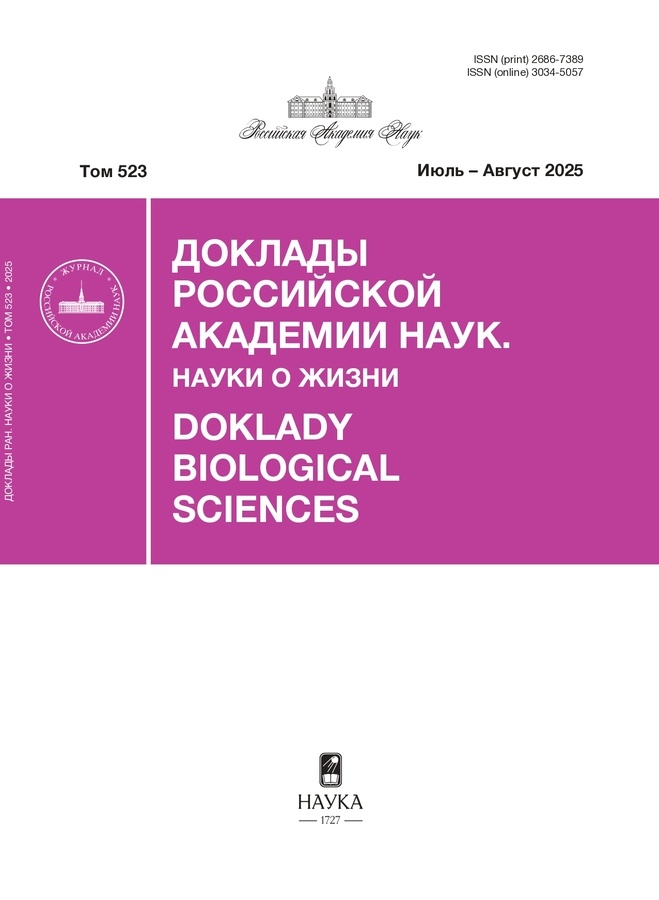Expression Level of Carotenoid Biosynthesis Genes in Leaves Is Associated with Cold Tolerance of Zea mays L. Plants
- Авторлар: Arkhestova D.K.1, Kochieva E.Z.1,2, Shchennikova A.V.1
-
Мекемелер:
- Institute of Bioengineering, Federal Research Center “Fundamentals of Biotechnology” of the Russian Academy of Sciences
- Moscow State University
- Шығарылым: Том 523, № 1 (2025)
- Беттер: 457-461
- Бөлім: Articles
- URL: https://pediatria.orscience.ru/2686-7389/article/view/693507
- DOI: https://doi.org/10.31857/S2686738925040133
- ID: 693507
Дәйексөз келтіру
Аннотация
The expression profile of key carotenoid biosynthesis genes (ZmPSY1, ZmPSY2, ZmLcyE) was determined in the dynamics of cold stress and post-stress recovery in the leaves of Zea mays L. plants of four cold-resistant (breeders' data) inbred lines: L-5580-1, L-6097-1, L-5254-3 and L-5272-6. It has been shown that under normal growing conditions the expression level of all three genes in the L-5580-1 line is significantly higher compared to other lines. It was revealed that low-temperature exposure affects the trends of gene expression fluctuations in a similar way between the lines. It was determined that in the dynamics of stress, the leaves of L-5580-1 plants are characterized by coordination of the co-expression pattern of the ZmPSY1 and ZmPSY2 genes with changes in the carotenoid content.
Негізгі сөздер
Авторлар туралы
D. Arkhestova
Institute of Bioengineering, Federal Research Center “Fundamentals of Biotechnology” of the Russian Academy of Sciences
Email: shchennikova@yandex.ru
Moscow, Russian Federation
E. Kochieva
Institute of Bioengineering, Federal Research Center “Fundamentals of Biotechnology” of the Russian Academy of Sciences; Moscow State University
Email: shchennikova@yandex.ru
Moscow, Russian Federation; Moscow, Russian Federation
A. Shchennikova
Institute of Bioengineering, Federal Research Center “Fundamentals of Biotechnology” of the Russian Academy of Sciences
Email: shchennikova@yandex.ru
Moscow, Russian Federation
Әдебиет тізімі
- Waadt R., Seller C. A., Hsu P. K., et al. // Nat. Rev. Mol. Cell Biol. 2022. V. 23(10). P. 680–694.
- Kidokoro S., Shinozaki K., Yamaguchi-Shinozaki K. // Trends Plant Sci. 2022. V. 27(9). P. 922–935.
- Matsuoka Y., Vigouroux Y., Goodman M. M., et al. // Proc. Natl. Acad. Sci. USA. 2002. V. 99. P. 6080–6084.
- Afrouz M., Sayyed R. Z., Fazeli-Nasab B., et al. // Peer J. 2023. V. 11. P. e15644.
- Soualiou S., Duan F., Li X., et al. // J. Exp. Bot. 2023. V. 74(10). P. 3142–3162.
- Ma H., Liu C., Li Z., et al. // Plant Physiol. 2018. V. 178(2). P. 753–770.
- Waititu J.K., Cai Q., Sun Y., et al. // Genes (Basel). 2021. V. 12(10). P. 1638.
- Rosas-Saavedra C., Stange C. // Subcell. Biochem. 2016. V. 79. P. 35–69.
- Zunjare R.U., Hossain F., Muthusamy V., et al. // Front. Plant Sci. 2018. V. 9. P. 178.
- Gallagher C.E., Matthews P. D., Li F., et al. // Plant Physiol. 2004. V. 135. P. 1776–1783.
- Li F., Vallabhaneni R., Wurtzel E. T. // Plant Physiol. 2008. V. 146(3). P. 1333–1345.
- Li F., Vallabhaneni R., Yu J., et al. // Plant Physiol. 2008. V. 147(3). P. 1334–1346.
- Efremov G.I., Slugina M. A., Shchennikova A. V., et al. // Plants. 2020. V. 9(9). P. 1169.
- Bonnecarrère V., Borsani O., Díaz P., et al. // Plant Sci. 2011. V. 180(5). P. 726–732.
Қосымша файлдар









